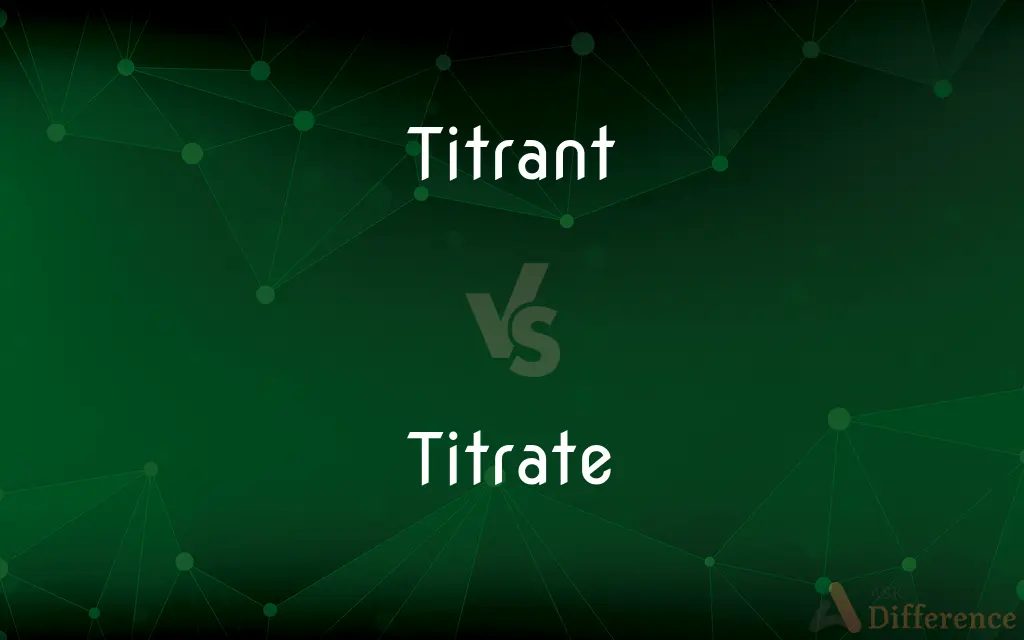Titrant vs. Titrate — What's the Difference?
By Tayyaba Rehman & Fiza Rafique — Updated on September 14, 2023
Titrant is the solution of known concentration used in a titration. Titrate refers to the process of determining the concentration of an unknown solution by adding a titrant to it.

Difference Between Titrant and Titrate
Table of Contents
ADVERTISEMENT
Key Differences
Titrant is a term used to describe the solution with a known concentration that is added to another solution to determine the latter's concentration. Titrate, on the other hand, is a verb that refers to the act of conducting a titration experiment. While the titrant is a substance, titrate is an action, demonstrating a key difference in their roles within a titration process.
Titrant usually comes in a burette or pipette, which allows for precise measurement and delivery into the solution being analyzed. To titrate means to carry out the titration by carefully adding the titrant until a specific end point is reached. Titrant is a physical entity, whereas titrate is the methodological approach to using that entity.
Titrant often contains an acid or a base that will react with the unknown solution in a predictable manner. When you titrate, you are essentially measuring how much of the titrant is needed to fully react with the substance in the unknown solution. The titrant is the "tool," so to speak, while to titrate is to employ that tool in the analysis.
In terms of their linguistic categorization, 'titrant' is a noun, whereas 'titrate' is a verb. The titrant serves a specific role in the experiment, while to titrate is the process that utilizes the titrant for analytical chemistry. Both terms are often used in tandem but serve very different functions within the context of titration.
Comparison Chart
Part of Speech
Noun
Verb
ADVERTISEMENT
Role
Substance used
Action performed
Usage
Found in burette or pipette
Conducting the experiment
Type
Usually an acid or base
Methodological approach
Context
Part of the titration setup
Describes the titration process
Compare with Definitions
Titrant
Usually an acid or base in a titration experiment.
We used a strong acid as the titrant.
Titrate
To determine the concentration of a solution by adding a titrant.
We had to titrate the solution to find its exact acidity.
Titrant
A solution with a known concentration used in titration.
Sodium hydroxide served as the titrant in the acid-base titration.
Titrate
The process of conducting a titration experiment.
It's essential to titrate carefully to achieve accurate results.
Titrant
The measured solution in titration procedures.
Ensure the titrant is of known concentration for accurate results.
Titrate
The method of using titrant in an analytical chemistry experiment.
The students learned to titrate in their chemistry class.
Titrant
The substance added to an unknown solution to determine its concentration.
The titrant was dispensed from a burette.
Titrate
To assess the quantity of a substance by titration.
He will titrate the sample to estimate its chemical composition.
Titrant
A reagent in a titration that reacts predictably with the unknown solution.
The titrant reacted completely, indicating the end point.
Titrate
Ascertain the amount of a constituent in (a solution) by measuring the volume of a known concentration of reagent required to complete a reaction with it, typically using an indicator
The sample is titrated at a pH near 10 with EDTA solution
Titrate 25 cm³ of this solution against 0.10 M hydrochloric acid
Titrant
A substance, such as a solution, of known concentration used in titration.
Titrate
To determine the concentration of (a solution) by titration or perform the operation of titration.
Titrant
(analytical chemistry) The reagent of known concentration and volume used in titrations.
Titrate
(analytical chemistry) To ascertain the amount of a constituent in a solution (or other mixture) by measuring the volume of a known concentration (the "standard solution") needed to complete a reaction.
Titrate
To adjust the amount of a drug consumed until the desired effects are achieved.
Titrate
(figuratively) To precisely control.
Titrate
To analyse, or determine the strength of, by means of standard solutions. Cf. Standardized solution, under Solution.
Titrate
Measure by (the volume or concentration of solutions) by titration
Titrate
To add a titrant dropwise to an unknown solution.
She began to titrate the unknown substance slowly.
Common Curiosities
Is Titrant a Substance or a Process?
Titrant is a substance.
What does Titrate mean?
To titrate means to determine the concentration of an unknown solution by adding a titrant.
What is Titrant?
Titrant is the solution of known concentration used in a titration experiment.
What does it mean to Titrate accurately?
To titrate accurately means to carefully add the titrant in a controlled manner.
What happens if you Titrate too quickly?
If you titrate too quickly, you risk passing the endpoint
Is Titrate a Noun or a Verb?
Titrate is a verb.
From where is Titrant typically dispensed?
Titrant is typically dispensed from a burette or pipette.
Is Titrant always liquid?
While titrants are generally liquid solutions, they can also be gases in some specialized titrations.
Why is it important to Titrate slowly?
Titrating slowly ensures a more accurate measurement of the unknown solution's concentration.
What is usually in the Titrant?
Titrant usually contains an acid or a base.
How do you Titrate?
You titrate by adding a titrant to an unknown solution until an endpoint is reached.
Can Titrant be hazardous?
Depending on the chemical, a titrant can be hazardous and should be handled with care.
When do you Titrate in an experiment?
You titrate when you need to find the concentration of an unknown solution.
Is Titrant specific to certain types of reactions?
Titrant is chosen based on the specific type of reaction being studied.
Share Your Discovery

Previous Comparison
Deduction vs. Reduction
Next Comparison
Present vs. AbsentAuthor Spotlight
Written by
Tayyaba RehmanTayyaba Rehman is a distinguished writer, currently serving as a primary contributor to askdifference.com. As a researcher in semantics and etymology, Tayyaba's passion for the complexity of languages and their distinctions has found a perfect home on the platform. Tayyaba delves into the intricacies of language, distinguishing between commonly confused words and phrases, thereby providing clarity for readers worldwide.
Co-written by
Fiza RafiqueFiza Rafique is a skilled content writer at AskDifference.com, where she meticulously refines and enhances written pieces. Drawing from her vast editorial expertise, Fiza ensures clarity, accuracy, and precision in every article. Passionate about language, she continually seeks to elevate the quality of content for readers worldwide.
















































